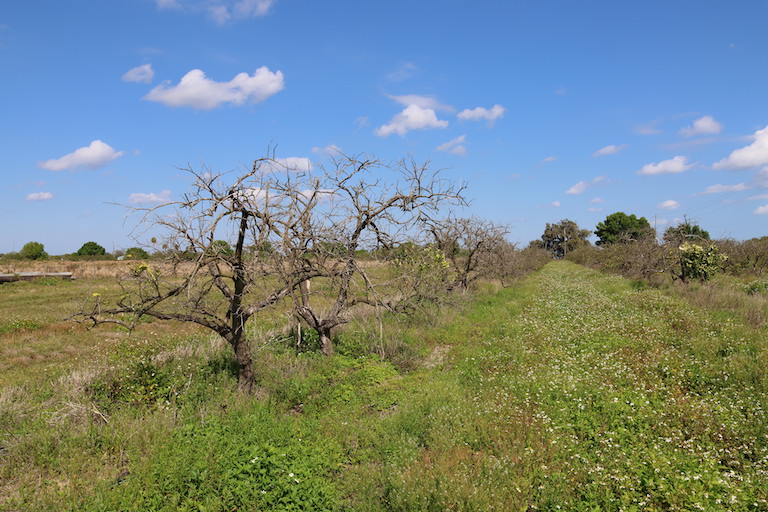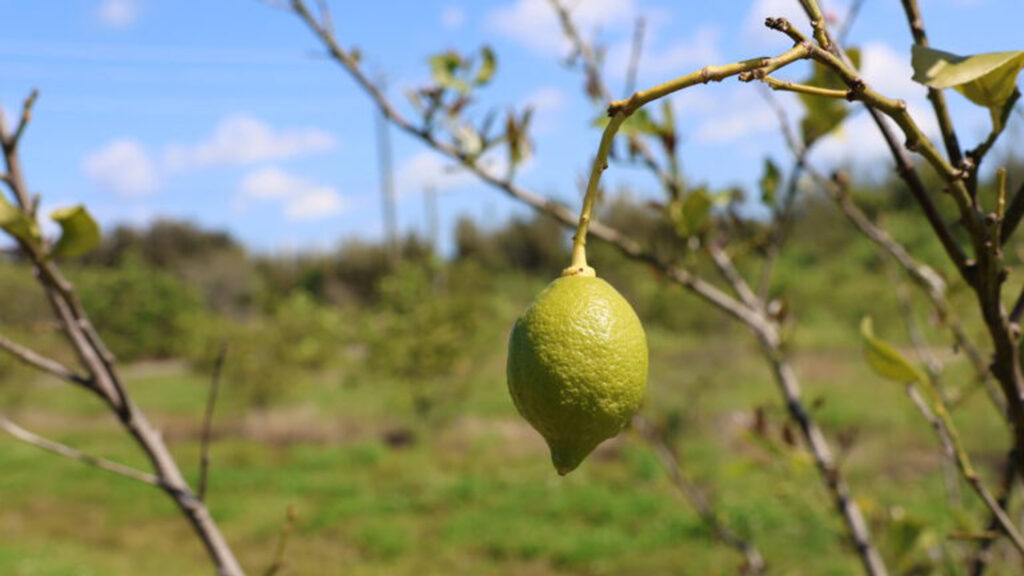FORT PIERCE, Florida — Just off of North Kings Highway, a dirt road once led to lush rows of sweet-smelling citrus crops: grapefruits, lemons and oranges. Now, all that’s left of the once-flourishing groves are barren rows of dead trees, weeds and a few sickly fruits still clutching to their final nutrients.
Florida was once a global capital for citrus production. But in 1998, a state entomologist discovered a tiny insect called the Asian citrus psyllid (Diaphorina citri). It was an ominous sign; the invasive pest transmits a pathogen that causes citrus greening disease, or huanglongbing, which slowly kills the trees and turns the fruit bitter.
It took seven more years to identify the first confirmed case. Over the past two decades, the disease has virtually decimated the state’s industry. Projections for this year’s orange production, the most abundant citrus crop grown in Florida, sit at just under 20 million boxes — down from more than 200 million boxes in the early 2000s, before the disease had spread.
Since then, the world’s leading scientists have poured endless time and money into rescue efforts, including mesh protective covers to block the pest from infecting young trees, disease-tolerant hybrid varieties and antibiotic trunk injections. Yet the disease continues spreading.

Now, a team from Argentina is testing a cheaper and simpler technique to control psyllids — sometimes called jumping plant lice — in Florida’s groves. It’s a method known as push-pull pest management; the idea is to repel pests away from crops and to lure them toward a more appealing “trap crop” planted on the perimeter of the farm.
“We’re working on insect behavioral manipulation” by distracting the pest with more-attractive plants, protecting oranges and other citrus fruits, team leader María Victoria Coll-Aráoz told Mongabay.
Push-pull pest management isn’t new. It’s a low-maintenance technique that farmers have used for the past 30-some years in parts of East Africa where it greatly helped maize crops for smallholder farmers. It’s an intercropping method considered part of agroecology, a holistic farming approach that prioritizes ecosystem health while addressing other aspects like producing enough yield for food security and ditching harmful chemicals for human and ecosystem health.
But Coll-Aráoz’s team is taking it a step further. They are spraying the citrus with an organic plant hormone that represses the plant’s production of a naturally produced chemical called methyl salicylate, the compound that attracts psyllids and other pests. The hormone works by blocking the plant’s biosynthetic pathway that releases this chemical. When a tree becomes infected with citrus greening, it produces even more methyl salicylate — a positive feedback loop “designed by the bacteria for its own propagation,” as Coll-Aráoz explained.
The idea is to spray trap crops with the attractive methyl salicylate, luring insects to those plants instead. Another way is to deploy methyl salicylate via plastic dispensers that act as perfume bottles to attract the insects. Coll-Aráoz co-founded a startup called Semion to market these organic solutions at an affordable price. Ideally, growers would spray crops during a growth phase called flushing, when new shoots and leaves are growing.
The psyllid likes to lay eggs inside those tiny leaf hammocks and feed on the leaves, “drooling” into the plant, which is how they transmit the bacteria (Candidatus Liberibacter asiaticus) that cause citrus greening. This triggers an immune response that clogs the tree’s “arteries,” called phloem, preventing sugar and other nutrients from traveling through the plant. It’s a slow, prolonged death.
“The disease has this insidious, long incubation period before you see symptoms,” Stelinski explained — sometimes years. That’s why it can be so difficult to control.
Testing the technique

In Fort Pierce, about 2 1/2 hours north of Miami on Florida’s east coast, Coll-Aráoz and her collaborators have designed an experiment to test this technique on young Valencia oranges (Citrus sinensis ‘Valencia’). There are three plots: One with untreated crops, a second with crops treated with the plant-hormone spray and a third also treated with plant hormones but surrounded by curry leaf plants (Murraya koenigii) as the trap crop, which are sprayed with methyl salicylate.
Curry leaf is a good insect trap for several reasons, Coll-Aráoz said. Their strong scent out-smells the citrus crops, making them more attractive to the insects than the citrus. Add the non-synthetic methyl salicylate, and the curry plants become even more attractive. Curry leaf is also immune to the pathogen that causes citrus greening. But even if a different trap crop is used, the idea is for the psyllids to live out their days on those plants instead of the crop that farmers are trying to protect. Methyl salicylate also attracts the pests’ natural predators, like wasps, which should help lower psyllid populations.
“The idea of putting the Murraya plants around the citrus plants is that any psyllid coming from outside will like these plants more,” Coll-Aráoz said. In essence, this makes the valuable citrus crops smell like “burnt toast” to the psyllid while making the trap crops smell like a much more appealing avocado toast, she explained.
Coll-Aráoz is also testing the push-pull technique using plant hormones on corn in Argentina, where the corn leafhopper (Dalbulus maidis) is transmitting a disease called corn stunt spiroplasma.
Lukasz Stelinski, a leading entomologist at the University of Florida, said he thinks the technique could be used effectively for avocados, too. His lab has tested the push-pull strategy on the redbay ambrosia beetle (Xyleborus glabratus), a pest causing a disease called laurel wilt. But so far, his team’s dispensers aren’t out-smelling the avocados’ natural scent. Stelinski said if they were able to change the way the avocado tree smells, like Coll-Aráoz is doing with citrus, “I think it could make a difference.”
So why hasn’t anyone tried it earlier?
Focusing on Florida
In 2022, international juice company Tropicana closed its Fort Pierce processing facility from a lack of fruit supply, firing 27 employees. It wasn’t the first to shut down.

“It’s difficult to imagine being much worse off in our industry right now,” Fred Gmitter, a plant breeder at University of Florida’s Citrus Research and Education Center, said in 2022. “I ask this question all the time: Is this the bottom? Is this as bad as it’s going to get?”
Over the past two decades of citrus greening in Florida, dozens of approaches have fallen short. And some solutions, like disease-resistant varieties, take years to develop. So far, oxytetracycline hydrochloride trunk injections, a relatively recent tool, have had the most success. But they’re also the most expensive option and the method treats infected trees retroactively to improve fruit yield and quality, like taking medicine when you’re sick. The injections also come with risks: Injecting trees incorrectly can kill them.
“Pesticides haven’t worked to control this vector, and we’re entering a time when these alternatives are unsustainable,” said Stelinski, the entomologist. “They’re too expensive. They’re having negative impacts in terms of insecticide resistance development, and they’re not working.”
Semion’s biological-trap approach, by contrast, aims to prevent infection entirely, at a fraction of the cost of most other solutions, including pesticides.
But their efforts to introduce push-pull in Florida have been met with mixed feedback.
“I was sort of astonished at how reluctant producers are to test something new, even if they know that everything else hasn’t worked,” Coll-Aráoz said. She said some growers worry that by planting trap crops, they will be attracting more psyllids to their groves. But the insects are already there — so much so that eradicating them isn’t possible.
“We’ve all come to learn that it’s just not feasible to try to eliminate the psyllid,” said Pat Schirard, a Florida Citrus Commissioner and grower. “They’re just endemic throughout the state.”
Schirard is one of several growers in Central Florida allowing Coll-Aráoz’s team to set up real-time experiments in their groves. The team is also conducting experiments in Stelinski’s lab at the Citrus Research and Education Center.
“I’m hopeful, of course, about this research,” Stelinski said, but added, “I’m not hopeful that this will be a massive paradigm shift or that it will be a savior of some sort or a silver bullet.”
Instead, he said he can envision push-pull being part of a wider management system to help reduce psyllid populations. “One of the things that we’ve learned over these past 15 years with citrus greening is that it’s very unlikely that there will be one tool or one approach that’s going to make a difference,” he added. “This really has to be an integrated approach.”
The sentiment rings true among growers. “In my view, there is no one answer,” Schirard said. “It’s going to be a combination of things, and it starts with diminishing the psyllid population in any way possible. We’d love to accomplish that without the use of additional sprays or pesticides.”

Heavy pesticide use comes with many drawbacks: Not only do several formulas pose serious health concerns such as developmental and brain defects in young children, but they can also lead to pest resistance, which is when pests evolve to survive the toxicity. Scientists usually recommend rotating different types of pesticides or, better yet, incorporating other types of pest control to avoid this problem.
It’s with this integrated approach in mind that Coll-Aráoz and her business partner, Emilio Molina, co-founded Semion.
“Something really important is that we want to make this technology easily integrated” into farmers’ existing pest management strategies, Molinas said, who is a third-generation farmer from Ecuador.
Meanwhile, citrus growers in Argentina and Brazil have fared much better, in part because they learned from Florida’s mistakes, but also because of more aggressive pest management.
In Brazil, unlike Florida, it’s legal for the government to kill infected trees in private groves. Whereas Florida sprayed pesticides once a month, Brazil sprayed once a week. And Brazil has large, sprawling groves, making it easier to do aerial sprays. Florida, by contrast, has fragmented groves interspersed with superstores and housing developments, making wide-scale control difficult. But Brazil’s heavy dependence on pesticides, many known to be dangerous, has come with its own slew of concerns, including environmental pollution, harm to wildlife and human health effects such as childhood cancer deaths.
The push-pull approach has been less popular in the U.S. likely because it misaligns with the priorities of Western agriculture, Stelinski added. After World War II, agriculture became heavily mechanized, reliant on agrochemicals and focused on high yields.
“It’s easy, it’s accessible, it’s within the already calculated input costs based on the profit you’re going to get from yield,” he said. Push-pull takes more effort: Farmers need a deeper understanding of pest behavior and have to sacrifice some land for trap crops.
But Florida is desperate.
“We’re all in this together at this point,” Schirard said, “which is the reason that I was amenable to working with Victoria and her group. If you’ve got an idea that may help me or my fellow Florida citrus growers, please, bring it on.”
Mongabay is a U.S.-based nonprofit conservation and environmental science news platform. Marlowe Starling is a freelance environmental journalist who writes about conservation, climate change and pollution, with bylines in Mongabay, Environmental Health News, Earth Island Journal, the Associated Press and a variety of Florida news outlets. This piece was originally published at https://news.mongabay.com/2024/04/florida-citrus-growers-hope-push-pull-agroecology-method-will-save-their-industry/.
Sign up for The Invading Sea newsletter by visiting here. If you are interested in submitting an opinion piece to The Invading Sea, email Editor Nathan Crabbe at ncrabbe@fau.edu.


